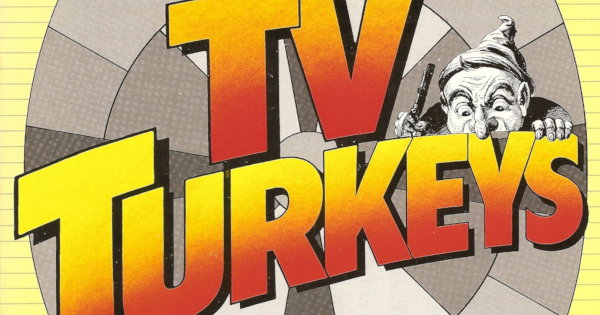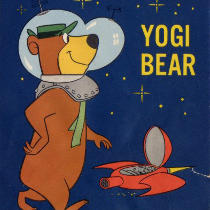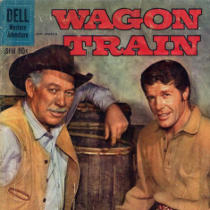Writing about TV tie-in novelizations last week got me to thinking about the very first television tie-in novel. What was it? I haven’t been able to find the answer and part of the problem is defining a tie-in novel. The earliest tie-ins were likely hardcover illustrated stories published by Whitman Publishing (a subsidiary of Western Publishing). The company began publishing books featuring licensed characters from film, radio and eventually television. One of the earliest Whitmans that might be considered a TV tie-in is Gene Autry and the Badmen of Broken Bow, first published in 1951. According to Kurt Peer in TV Tie-Ins: A Bibliography of American TV Tie-In Paperbacks, “Whitman, which had been publishing Gene Autry books since the 1940’s, continued to publish them, with show-mention, once the show aired” [1].
Additional Whitman titles published in the early 1950s included Roy Rogers and the Rimrod Renegades, Gene Autry and the Big Valley Crab and Rin Tin Tin’s Rinty. Again, these likely had less to do with any television programs and more to do with the characters themselves. Two books published in 1955 may be among the first actual tie-ins: The $64,000 Question Official Quiz Book (Dell) and The Life of Davy Crockett (Signet). The latter was said to be written by Crockett himself and coincided with the 1954-1955 ABC Disneyland episodes starring Fess Parker.
Peer called Frontier: 150 Years of the West, published by Bantam in 1955, an “inferred TV tie-in” because it was “similar to the Western anthology TV show Frontier” despite the fact that the book made no mention of the show. It was published four months after Frontier premiered, however, so it very well may have been a tie-in [2]. Dragnet: Case No. 561 was published in 1956 by Pocket. Written by Richard S. Prather under the pen name David Knight, it may be the very first original story related to a television show. In 1957 Ballantine published Gunsmoke, a novelization of ten radio and television episodes, and Sergeant Bilko, which reprinted ten shooting scripts.
The next original novels may have been Wagon Train: Wagonmaster and Wagon Train: The Scout, both written by Robert Turner and both published in 1958 by Pocket. Also published in 1958 were Dragnet: The Case of the Courteous Killer (Pocket) and Alfred Hitchcock Presents: 12 Stories They Wouldn’t Let Me Do On TV, a collection of short stories (Dell). The following year brought Dragnet: The Case of the Crime King (Pocket) and Dragnet: The Badge (Crest).
The first year of the decade saw a slew of tie-ins: Have Gun, Will Travel (Dell), Johnny Staccato (Gold Medal), Leave it to Beaver (Berkley Medallion), Peter Gunn (Dell), The Deputy (Dell) and Men Into Space (Berkley) were all published in 1960. With the exception of Leave it to Beaver, which consisted of novelizations, I believe all of these were original stories. The earliest tie-in novel in my personal collection is The Americans, published in 1961 by Popular Library.
To sum up, the very first tie-in novel with an original story may be Dragnet: Case No. 561, published in 1956. The first tie-ins of any sort were likely Whitman stories based on licensed characters like Gene Autry and Roy Rogers. If anyone has information about an earlier original story or can shed some light on whether the Whitman stories published in the early 1950s were actually intended as TV tie-ins, please let me know.
Works Cited:








THE BADGE was not a DRAGNET tie-in as such, rather a book-length documentary tribute to the Los Angeles Police Department, under Jack Webb’s byline. It consisted of true stories from LAPD files, using real names and photos. Reputedly, THE BADGE was the first book in hardcover to include a writeup of the Black Dahlia murder case.
I once owned the hardcover edition of this book, which would have come out about a year before the Crest paperback. (I can’t recall the hardcover publisher.)
THE BADGE was reissued as a trade paperback a few years ago, with a highly profane introduction by novelist James Ellroy that I’m certain would have made the conservative Webb cringe.
Thanks for the clarification, Mike.
The Dell editions of STORIES THEY WOULDN”T LET ME DO ON TV was actually a reprint, from the Random House hardcover that included roughly twice as much text, and was one of a long series of ALFRED HITCHCOCK PRESENTS: anthologies published by Random House and actually edited by Robert Arthur, till his death in 1969, and then by Harold Q. Masur till HItchcock’s death in 1979. Though this volume could be said to have been edited, at least in part, by network censors.